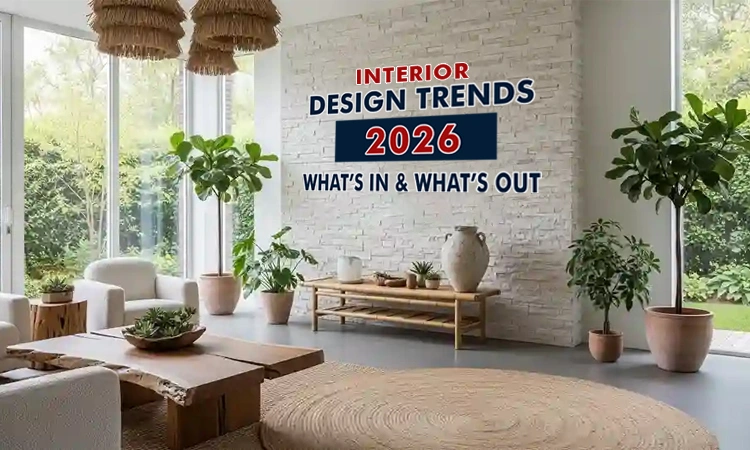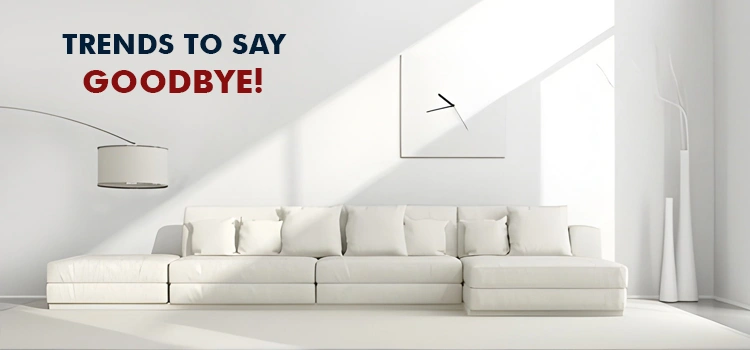
Interior Design Trends 2026: What’s In & What’s Out
Interior design is changing faster than ever, merging sustainability, smart technology and timeless beauty in our living spaces. As we move into 2026, homes are no longer about style; They’re about purpose, comfort and personality.
From warm, natural colors to multifunctional spaces, this year’s trend is toward homes that are practical yet deeply personal. Let’s find out what’s making waves in the design world—and what’s falling out of favor.
What's In: 2026 Interior Design Trends to Follow
1) Sustainable & Eco-Conscious Design
Sustainability is the cornerstone of interior design trends in 2026. Eco-friendly materials like bamboo, recycled glass, reclaimed wood, and low-VOC paints are increasingly favored by designers and homeowners. Today’s green interiors prove that low-impact design can also be beautiful.
Expect a rise in the use of recycled furniture, finishes in natural stone, and organic textiles such as linen and hemp. Energy-efficient lighting solutions and green building certification are also fast becoming the norm.
2) Warm neutrals and earthy hues
Time to say goodbye to cold greys, for 2026 is the year for warmth and comfort. Earthy tones including terracotta, caramel, taupe, and clay are taking over minimalist whites. Such shades give an inviting feel, organic and so immediately cozy and earthbound.
You’ll also see the rise of deep olive greens, muted blues, and sand-inspired beiges with such textured surfaces as jute rugs, rattan furniture, and linen curtains. This palette works well in both modern and traditional interiors.
3) Smart Homes with Seamless Technology
Technology is part of our daily home life now, and in 2026, it blends beautifully with design. According to Interior Design Trends 2026, the modern home is evolving into a space where technology and aesthetics coexist effortlessly. From smart mirrors and automated curtains to AI-powered lighting and temperature control, modern homes are becoming more intuitive and efficient.
But the focus is not only on functions; the trend is for invisible integration, where devices fade into the background so as not to disturb the aesthetic values of the space. Wireless charging pieces of furniture and smart appliances are prevalent in the kitchen.
4) Multifunctional and Flexible Spaces
Interior layouts are made to ensure flexibility, considering lifestyles brought about by the pandemic. The homes in 2026 will be designed to adapt to various needs: a living room that can become an instant workroom, a dining area doubling into a study zone, or modular furniture that can easily be moved around.
These are increasingly likely to include Murphy beds, collapsible desks, and mobile partitions. Open floor plans are being reconceptualized as “zoned spaces” where residents are able to curate their environment to be productive or unwind.
5) Statement Ceilings and Textured Walls
If 2025 was all about accent walls, then 2026 takes it further-up to the ceiling. Designers are playing with bold colors on the ceiling, patterned wallpapers, and even wooden beams to draw the eye upward.
Also now very in are textured walls, whether with limewash, Venetian plaster, or fluted panels. Such finishes add so much character and depth, making the simple wall the center of the room. Metallic accents and geometric tiles also make their return for bathrooms and kitchens.
6) Biophilic Design: Bringing the Outdoors In
Bringing the Outdoors In Nature continues to inspire interior spaces. Biophilic design, with the emphasis on natural light, greenery, and organic materials, is perhaps more popular than ever. Large windows, indoor gardens, vertical plant walls, and water features are integrated into homes as a means of creating a calming environment.
This is intended to create an environment that will enhance mental well-being, cut down on stress, and bring about purer air. Natural ventilation, skylights, and earthy decorative elements, with stone planters and woven textures, embrace this connection to nature.
7) Vintage Revival with a Modern Twist
Now, with very modern sensibilities, retro-inspired decor is making a comeback. Think mid-1900s furniture with curved edges, nostalgic prints, and modern finishes. Besides giving a room much-needed character, vintage promotes recycling and repurposing.
Homeowners today prefer customized and artisanal designs that tell a story more than mass-produced décor. Statement lighting from unique finds to repurposed furniture and flea market finds dominates 2026 home design.

What’s Out: Trends to Say Goodbye To
1) All-White Minimalism
Stark all-white homes have started to feel a bit too sterile, even though minimalism will always have its appeal. Today’s homes are veering toward “warm minimalism”: neutral color schemes combined with warm wood tones, cozy textures, and layered lighting.
2) Fast Furniture
We are past the disposable furniture era; individuals nowadays invest in better quality pieces of furniture that can last for decades rather than months. Custom-made furniture and locally made items have taken center stage rather than mass-produced imports.
3) Overly Industrial Aesthetics
Gone are the raw concrete, exposed pipes, and dark metal tones that defined industrial chic, as softer and more refined materials replaced them. Industrial looks are becoming more hospitable, marrying rustic warmth to modern polish.
4) Matching Everything
2026 is the year of diverse patterns, colors, and textures; uniqueness and contrast are key. Creating spaces that feel more authentic instead of fabricated is the goal.
The Home Renovation Focus: Comfort Meets Functionality
In 2026, homeowners are renovating for lifestyle rather than just aesthetics. These days, the main goals of a home renovation are increasing energy efficiency, maximizing storage, and making smart use of natural light.
The emphasis today is on renovations that enhance daily living, from open kitchen concepts to cozy reading nooks and spa bathrooms. Designers recommend the use of hybrid materials that balance durability with looks-such as quartz countertops, matte-finish laminates, and waterproof vinyl flooring.
Plan for long-term flexibility in your remodel: spaces designed with adaptability in mind allow your home to accommodate new functions in the future, like a corner that could be for a future home office or a guest room that converts.
Overview
The interior design of 2026 is all about warmth, personal touch and sustainability. Homes are increasingly becoming ‘smart’, more human-centric environments where technology, nature and artistry blend seamlessly. As old trends, such as sterile minimalism and loud furniture, disappear – a more thoughtful and artistic approach to living space comes front and center.
Whether refreshing your current setup or planning a complete renovation, these are the perfect trends to take inspiration from building a home that feels timeless yet completely your own.
Frequently Asked Questions (FAQs)
How can I update my home for 2026 trends without a full renovation?
You can easily refresh your home by adding warm earthy tones, textured walls, sustainable materials, and smart lighting systems. Small decor swaps can make a big visual impact.
Are sustainable materials more expensive than traditional ones?
Not always. While some eco-friendly materials have higher upfront costs, they last longer and reduce maintenance expenses—making them more cost-effective in the long run.
What are the best interior design trends for small apartments in 2026?
Multifunctional furniture, zoned layouts, and light, warm colors help maximize small spaces while keeping them stylish and cozy.
How do I incorporate smart home technology without ruining my home’s aesthetics?
Opt for invisible integrations like automated curtains, built-in sensors, and furniture with hidden charging ports. These enhance convenience without visual clutter.
Which colors are going out of style in 2026?
Cool grays, stark whites, and overly industrial tones are fading out. Designers now favor warm neutrals like terracotta, taupe, and olive green.
What are the most timeless interior design choices for 2026 and beyond?
Natural textures, biophilic elements, and handcrafted or vintage pieces are long-lasting trends that stay relevant beyond 2026.
How can I make my home more energy-efficient while following 2026 trends?
Use LED lighting, energy-rated appliances, and natural ventilation. Combine these with sustainable materials for an eco-conscious, modern home.

 Get an expert-reviewed estimate tailored to your project, location, and budget. Share your details for an accurate construction or renovation cost.
Get an expert-reviewed estimate tailored to your project, location, and budget. Share your details for an accurate construction or renovation cost.